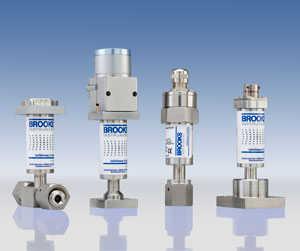
Last week, Brooks launched a line of
industrial pressure transmitters, the SolidSense II® (ATEX). These join our existing line of
ultra-high purity pressure transducers, the SolidSense II®.
Fast facts about the industrial pressure transmitters, SolidSense II® (ATEX):
- Superior corrosion resistance with a 316L stainless steel, chromium enriched wetted flow path, making them suitable for virtually all process fluids;
- Digital temperature compensation enabling improved process pressure measurement in plants subject to wide temperature variations;
- High accuracy combined with FM and ATEX compliance make the SolidSense II (ATEX) the optimum choice for demanding applications.
We see the Solid Sense II (ATEX) pressure transmitters becoming a transmitter of choice in variety of industries such as food, beverage, dairy and pharmaceuticals. Typical applications will include measuring the liquid level in tanks, measuring build-up across filters, monitoring pump discharge, etc.
Fast facts about the ultra-high purity pressure transducers, SolidSense II®:
- They offer lowest cost of ownership for high purity gas distribution systems through virtually zero maintenance operations;
- The transducers don't require zero adjustment immediately after installation, so engineers can start equipment quickly, increasing productivity;
- During purge cycles, the SolidSense II will not temporarily indicate inaccurate pressure readings. Superior design and construction are able to handle millions of purge cycles.
- The ultra-stable, micro machined silicon strain gauges are matched and glass fused at high temperature to the metal diaphragm. This process reduces drift commonly associated with competitive products.
The SolidSense II pressure transducers have gained a foothold in ultra-high purity applications in semiconductor manufacturing. They can be found in gas cabinets, gas panels, valve manifold boxes and distribution valve boxes, which all require highly reliable pressure measurement.
Want to know more about the SolidSense II pressure transmitters and transducers?
Click here.